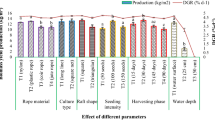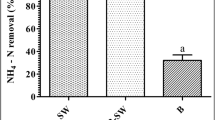Abstract
This study explores the possibilities of converting the largely underutilized potential coastlines of Andaman Island to profitable seaweed farming sites, particularly at South Andaman. Present study, surveyed a total of five stations to locate the best possible site for seaweed mass production, of which two locations were selected based on geomorphology, water quality parameters and ease of access. The pilot scale study was done from 2018 – 2021 to understand the feasibility of seaweed farming in this Island. The first culture initiation was done at North Bay using Gracilaria edulis (G. edulis) and Acanthophora spicifera (A. spicifera) in floating bamboo raft. Seaweeds were tied using two different methods i.e.direct insertion to ropes and pouch filling. The results suggested that pouch filling method not only increases the yield but also lowers wash out occurrences in rough sea. The G. edulis species was found to grow well in the bamboo rafts with DGR of approximately 135 gm (± 0.085gm)/Kg. About 155–180 kg of G.edulis were harvested from 7 raft seasonally with 17.5 kg of input biomass, in this trial study. The main challenges experienced during the trial were, seasonality of preferable seed material, prolonged rainy seasons, cyclonic events, wave action and turbidity due to sedimentation, fouling by undesirable algae. Even so, the prospects of extensive development of seaweed culture in these islands are high, provided, steady seed availability, selection of season, proper culture technique and practices are considered and applied.







Similar content being viewed by others
Data Availability
The authors confirm that the data supporting the findings of this study are available within the article [and/or] its supplementary material.
References
Aresta M, Dibenedetto A, Barberio G (2004) Utilization of macroalgae for enhanced carbon dioxide fixation and energy production. Am Chem Soc Div Fuel Chem 49:348–349
Bunting SW, Pretty J (2007) Global carbon budgets and aquaculture- emissions, sequestration and management options. Department of Biological Sciences, University of Essex, Colchester, UK, p 45
Dhargalkar VK, Pereira N (2005) Seaweed: promising plant of the millennium. Sci Cul 71:60–66
Ganesan M, Sahu N, Eswaran K (2011) Raft culture of Gracilaria edulis in open sea along the south-eastern coast of India. Aquaculture 321:145–151. https://doi.org/10.1016/j.aquaculture.2011.08.040
Hossain SABM, Salleh A, Boyce AN, Chowdhury P, Naqiuddin M (2008) Biodiesel fuel production from algae a renewable energy. Am J Biochem Biotechnol 4:250–254
Ingle KN, Polikovsky M, Chemodanov A, Golberg A (2018) Marine integrated pest management (MIPM) approach for sustainable seagriculture. Algal Res 29:223–232. https://doi.org/10.1016/j.algal.2017.11.010
Kaliaperumal N (2017) Studies on phycocolloids from Indian marine algae – A review. Seaweed Res Utilin 39:1–8. [Google Scholar]
Karthick P, Ramesh C, Mohanraju R (2021) A checklist of seaweeds of the Andaman and Nicobar Islands, India: a way forward for seaweed cultivation, food, and drug applications. Environ Monit Assess 193(10):671. https://doi.org/10.1007/s10661-021-09458-4. PMID: 34557981
Kim JK, Charles Y, Eun Kyoung H, Miseon P, Youngdae K (2017) Seaweed aquaculture: Cultivation technologies, challenges and its ecosystem services. Algae 32:1–13. https://doi.org/10.4490/algae.2017.32.3.3
Kılınç B, Cirik S, Turan G, Tekogul H, Koru E (2013) Seaweeds for Food and Industrial Applications. In: (ed) Food Industry. IntechOpen. https://doi.org/10.5772/53172
Liao YC, Chang CC, Nagarajan D, Chen CY, Chang JS (2021) Algae-derived hydrocolloids in foods: applications and health-related issues. Bioengineered 12:3787–3801. https://doi.org/10.1080/21655979.2021.1946359
Mantri VA, Kavale MG, Kazi MA (2020) Seaweed Biodiversity of India: Reviewing Current Knowledge to Identify Gaps, Challenges, and Opportunities. Diversity 12:13. https://doi.org/10.3390/d12010013
McHugh DJ (2002) Prospects for Seaweed Production in Developing Countries. Food and Agriculture Organization, Rome, Italy. ISSN 0429–9329. http://www.fao.org/3/y3550e/y3550e00.htm
Mohan PM, Kumari RK (2018) Conservation of Coral Reef Environment.In:Perspectives for Tropical Islands. Biodiversity and Climate change Adaptation in tropical Islands. In: Sivaperuman C, Velmurugan A, Singh AK, Jaisankar I (eds). Elseveir, pp 25–743
Mouritsen OG, Rhatigan P, Pérez-Lloréns JL (2018) World cuisine of seaweeds: Science meets gastronomy. Int J Gastron Food Sci 14:55–65. https://doi.org/10.1016/j.ijgfs.2018.09.002
Peñalver R, Lorenzo JM, Ros G, Amarowicz R, Pateiro M, Nieto G (2020) Seaweeds as a functional ingredient for a healthy diet. Mar Drugs 18:301. https://doi.org/10.3390/md18060301
Raju PV, Thomas PC (1971) Experimental field cultivation of Gracilaria edulis (Gmel.) Silva. Bot Mar 14:71–75
Robert LF (1995) Ephiphytism and fouling in Gracilaria cultivation: An overview. J Appl Phycol 7:325–333
Rocha CP, Pacheco D, Cotas J, Marques JC, Pereira L, Gonçalves AMM (2021) Seaweeds as Valuable Sources of Essential Fatty Acids for Human Nutrition. Int J Environ Res Public Health 18:4968. https://doi.org/10.3390/ijerph18094968
Shacklock P, Croft GB (1981) Effect of grazers on Chonder crispus in culture. Aquacul 22:31–34. cross reference
Subbaramaiah K, Thomas PC (1995) Raft Cultivation of Gracialria edulis (Gmel.) Silva. Proc Indian Acad Sci (plant Sci) 100:123–127
Tseng CK, Borowitzka M (2003) Algae Culture. In: Aquaculture: Farming Aquatic Animals and Plants, Lucas, J.S. and P.C. Southgate (Eds.). Wiley-Blackwell, New York, ISBN-10: 0852382227
The Seaweed site (2021). https://www.seaweed.ie/
Vairappan CA, Chung CS, Hurtado AQ, Soya FE, Lhonneur GB, Critchley A (2009) Distribution and symtoms of epiphytic infection in major carrageenophyte-producing farms. Nineteenth International Seaweed Symposium, vol 2. Springer, Amsterdam, pp 27–33
Vinithkumar NV, Sathish T, Das AK, Sivaperuman C, Raghunathan C, Dharani G, Kirubagaran R, Sujathkumar NV (2018) Marine Ecosystems of Andaman and Nicobar Islands- Species abundance and distribution. In: Sivaperuman C, Velmurugan A, Singh AK, Jaisankar I (eds) Biodiversity and Climate change Adaptation in tropical Islands. Elseveir, pp 217–256
Acknowledgements
The authors gratefully acknowledge the financial support given by the Ministry of Earth Sciences, Government of India, New Delhi to conduct the survey and research. The authors are thankful to Dr. G. A. Ramadass, Director, National Institute of Ocean Technology (NIOT), Chennai and former Director Dr. M.A. Atmanand, NIOT for constant encouragement and providing the necessary facilities to perform this research.
Author information
Authors and Affiliations
Contributions
Karuna Kumari R: Execution, methodology, collection, photography, identification, analysis, writing- Original draft preparation. N.V. Vinithkumar: Supervision, methodology, collection, photography, identification, review and editing, validation. G. Dharani: Reviewing and Editing
Corresponding author
Ethics declarations
Ethical Approval and Consent to Participate
Not applicable.
Human and Animal Ethics
Not applicable.
Consent for Publication
All the authors agree and give our consent for the publication of identifiable details, which can include photograph(s) and/or videos and/or case history and/or details within the text (“Material”) to be published in the above Journal and Article.
Conflicts of Interest/Competing Interests
The authors declare that they have no known competing financial interests or personal relationships that could have appeared to influence the work reported in this paper.
Additional information
Publisher's Note
Springer Nature remains neutral with regard to jurisdictional claims in published maps and institutional affiliations.
Rights and permissions
Springer Nature or its licensor (e.g. a society or other partner) holds exclusive rights to this article under a publishing agreement with the author(s) or other rightsholder(s); author self-archiving of the accepted manuscript version of this article is solely governed by the terms of such publishing agreement and applicable law.
About this article
Cite this article
R, K.K., N. V., V. & G, D. A Comprehensive Study on Mass Culture of Gracilaria edulis in Coastal Waters of South Andaman: Criterion, Constraints and Possibilities. Thalassas 39, 379–387 (2023). https://doi.org/10.1007/s41208-022-00502-9
Received:
Revised:
Accepted:
Published:
Issue Date:
DOI: https://doi.org/10.1007/s41208-022-00502-9




